Grossmont College borders the city of San Diego on the east. The college and children’s center serve a diverse population, including a large number of immigrants from the Middle East, Eastern Europe and Africa. The smallest of the original PITC demonstration programs, Grossmont cares for 26 children from 6 months through 3 years of age. They started serving two-year olds in 1989 and, with CalWORKS funding, expanded to include children from six months to three years.
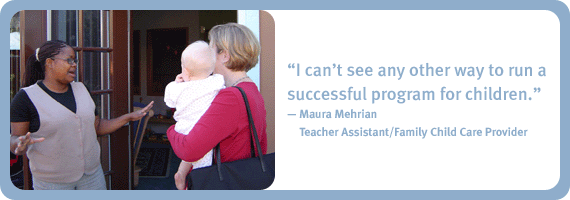
As part of becoming a demonstration program, Grossmont sought to create intimate care settings that reflect the PITC philosophy and policies. Children and families now stay in the same small groups with their primary infant/toddler care teachers from six months through the end of their third year. The infant/toddler care teachers and children move together to a new space at the beginning of each academic year. In effect since 1999, this approach to providing continuity of care allows relationships between children and infant/toddler care teachers and between the children’s families and infant/toddler care teachers to develop and deepen over time. In a nutshell, to support the children’s development and learning, this program engages in relationship planning instead of lesson planning. Relationship planning is a critical component of the PITC philosophy of care.
“Continuity of care is the best new idea to come into this profession in my entire 25 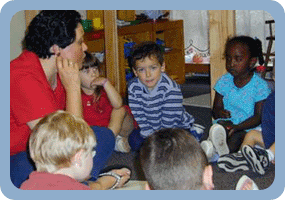 year career. After the children and families get comfortable with the care, the teacher’s job is much easier. Personally I do not have to spend a half a semester at the beginning of each and every year gaining the trust of the children and their parents. The children I get are happy to be with me, they are not “mourning” the loss of last year's teacher. The parents get to know and trust my judgment so when I have difficult things to discuss with them it is much easier and the child gets the needed help much quicker. It is much better for the child and after all, isn’t that why we are all here?”
year career. After the children and families get comfortable with the care, the teacher’s job is much easier. Personally I do not have to spend a half a semester at the beginning of each and every year gaining the trust of the children and their parents. The children I get are happy to be with me, they are not “mourning” the loss of last year's teacher. The parents get to know and trust my judgment so when I have difficult things to discuss with them it is much easier and the child gets the needed help much quicker. It is much better for the child and after all, isn’t that why we are all here?”
—Dawn Celyan, Toddler Teacher
When the children’s center became a PITC demonstration program, its facility consisted of a relocatable building licensed for 16 infants and toddlers, and a second room within a permanent building licensed for twenty four 24-36 month olds. The building for the infants and toddlers was set up as one big open room. Here’s what the original floor plan looked like:
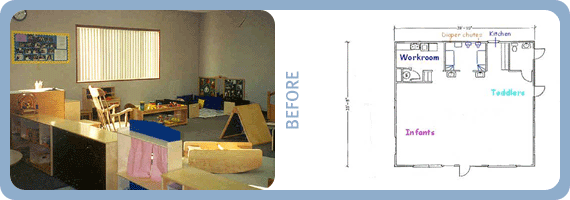
Before becoming a PITC demonstration program, the room for infants and toddlers had one door and was divided with furniture.
Funding from the California Department of Education’s Early Education and Support Division enabled Grossmont to transform the big room for infants and toddlers shown in the original floor plan into two small ones. In small care spaces, the program can offer individualized care in small groups as recommended by the PITC. Architect and PITC Faculty member Louis Torelli consulted on the project and a local design firm redesigned the space. To create two separate care spaces, a second entrance was added as well as a nap room and small service area for the infant group. The space was divided with angled full and half walls, creating an infant room for 6 children (approximately 6 –18 months of age) and a toddler room for 8 children (approximately 12 months to two years). Here’s the layout now:
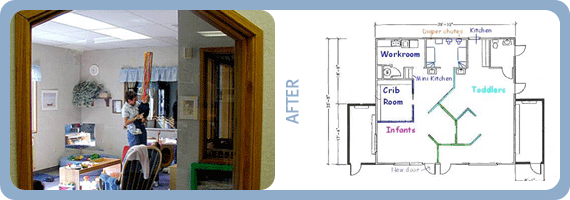
The new layout creates a series of mini rooms, as in a cozy home. There is a playroom, a bedroom, a kitchen dining area and, a big favorite of the children and infant/toddler care teachers, the parlor. Mirrors allow supervision of blind spots. The new observation room, which is used by college students, staff, families, and demonstration program visitors, is behind the teacher.

Here’s a photo of the toddler space before the PITC-inspired renovation. Toddlers were separated from the infants by furniture.

Here’s the new toddler space after becoming a demonstration program. It has multiple levels to explore, comfortable furniture and greater choice of play areas, all of which are recommended by PITC as key components of a high quality environment for toddlers.
One of the popular features is the window between the two separate care spaces. Both infants and toddlers are delighted when they eventually discover their neighbors.
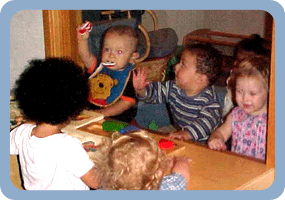
“Making the permanent division of the infant/toddler classrooms has given us the opportunity to function more independently, created small group interactions between teacher and infants, cut in half the noise level and also allowed for staff support and one on one mentoring with the new infant teacher.”
—Marisela Cerna, Master Teacher

The changing area was redesigned for convenience and improved site lines.
Twos Room was redesigned to create smaller groups of 8 in each classroom space.

In 2015, a partnership with Early Head Start allowed us to reduce the class size to 8 two year olds in each of the classrooms. These smaller groups promote individualized care with enhanced opportunities for play between the 2 environments and outdoor playground.

The renovation project also included outdoor play areas. Before the center became a demonstration program, a converted parking lot was serving as a play yard. The goal of the renovation was to create an outdoor garden space that provided direct access from the classrooms and flexible protected play spaces. Easy access to the outdoors and fresh air promotes health and provides infants with a greater variety of choices and freedom to explore as recommended by PITC.
The play yard renovation project was a collaboration between the children’s center and the Grossmont College Art Department. Students added interactive art elements including a textured rock path, and designs taken from nature and Kumeyaay rock art. The inclusion of the community, as this collaborative project illustrates, is an important theme in the PITC philosophy.
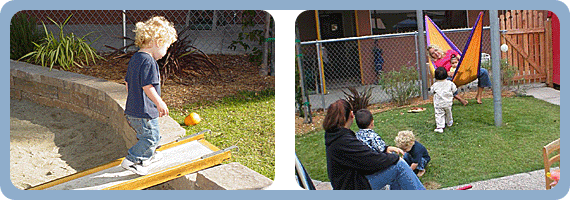
The new wall around the sand area was designed to also provide just the right level of challenge for toddlers.
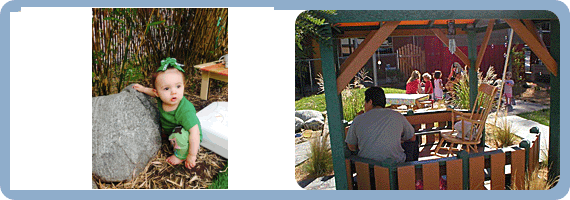
Bamboo was planted to cover the fence and screen the harshness of the parking lot. The gazebo and smaller grass area are for the younger infants. Grasses screen this area and herbs provide olfactory stimulation.

One of the favorite outdoor places is a cozy hammock. Just like with indoor spaces, it is important to create quiet places where children can safely be alone or with a small group of children.
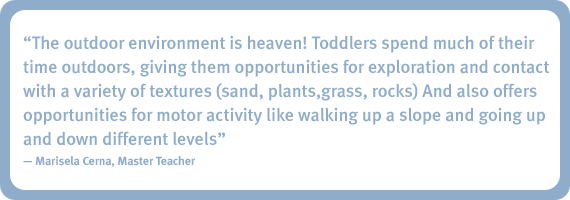

The small grassy area for the infants (left) provided a good place to add a portable piece of equipment to challenge this little girl. An example of a protected play space, it is out of the path of the toddlers with wheel toys.
The textured path (right) with local granite, imbedded agates and other beautiful stones, is an example of the kind of exploratory experience we can give young children who spend much of their time close to the ground.